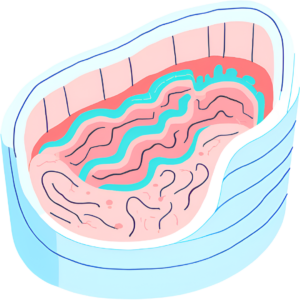Ever wondered why your SIBO breath test shows methane but no hydrogen? The answer lies in an ancient microscopic battle happening in your gut!
Small Intestinal Bacterial Overgrowth (SIBO) is a condition where bacteria get free reign in the small intestine, causing an excess of them. This leads to bloating, gas, constipation, and other digestive symptoms, because the small intestine usually have very few bacteria. Not all SIBO is the same. There are different types of SIBO, primarily categorized by the gases they produce: hydrogen, methane, and hydrogen sulfide.
In methane-dominant SIBO, archaea consume hydrogen produced by other bacteria and convert it into methane gas. This interaction doesn’t just affect your gut health; it can also skew the results of breath tests commonly used to diagnose SIBO.
In this article, we’ll break down how these archaea “eat” hydrogen, why your SIBO breath test shows methane but no hydrogen, and what this means for accurate diagnosis and effective treatment.
The Role of Hydrogen-Producing Bacteria in SIBO
When gut bacteria break down food through fermentation, they release hydrogen gas as a byproduct. When carbohydrates aren’t fully absorbed in the small intestine, they become food for other microbes, like methanogens, acetogens, and sulfate-reducing bacteria (1). This microbial teamwork plays a key role in keeping your gut environment balanced and your metabolism running smoothly.

When gut bacteria ferment undigested carbohydrates, they release hydrogen gas as a byproduct. In hydrogen-dominant SIBO, this gas builds up and can be detected using a breath test. Measuring hydrogen levels is key for diagnosing SIBO and determining which type—hydrogen, methane, or mixed—is causing the issue.
But the story doesn’t end there. Enter methane-producing archaea, ready to feast on that hydrogen.
Enter the Methane-Producing Archaea
When we talk about SIBO, we’re usually speaking of bacteria. After all, it’s Small Intestinal Bacterial Overgrowth. However, this is not completely correct. Thirty years ago, scientists figured out a new group of life forms on Earth called archaea. They are ancient microorganisms that can live in the most extreme conditions without oxygen, like freezing temperatures or intense heat (or your gut) (2). Technically, methane-dominant SIBO is therefore called Intestinal Methanogen Overgrowth (or IMO for short). The most notable player in methane-dominant SIBO is Methanobrevibacter smithii (3).

Energy
Methanogens turn carbon dioxide (CO₂) and hydrogen (H₂) into methane (CH₄) because, for them, it’s like charging their internal batteries. This process is how they make ATP, the essential energy molecule that keeps their tiny microbial systems running. In short, turning CO₂ and H₂ into methane isn’t just something they can do—it’s how they stay alive and thrive (4). This metabolic activity isn’t just a scientific curiosity—it directly impacts your breath test results and your gut health.
Interestingly, the microbes responsible for producing methane—the archaea—often get overlooked in studies about the human microbiome. Why? Well, they’re not bacteria, and most microbiome research tools are designed to detect bacterial DNA, not archaea. So, these little methane-makers tend to fly under the radar, even though they play a pretty big role in gut health (5).
How Methane Eats Hydrogen in the Gut
The interaction between hydrogen-producing bacteria and methane-producing archaea is a fascinating example of microbial teamwork—though it doesn’t always work in your favor. Because of how methane-producing archaea ‘eat’ hydrogen, the overall hydrogen levels in your gut decrease. If you have a high number of archaea in your gut and they are very active, the hydrogen levels on your breath test, while methane levels spike.

SIBO or IMO are usually diagnosed by breath tests that tests for hydrogen and methane on your breath. After following a specific diet & fast a few days prior, you take a sugary solution like glucose or lactulose. As gut bacteria break down the sugar, they produce hydrogen or methane gas, which gets absorbed into your bloodstream and eventually exhaled through your breath. By tracking these gas levels over time, doctors can pinpoint whether you have hydrogen-dominant, methane-dominant, or hydrogen-sulfide SIBO.
Because methane-producing archaea eat hydrogen to stay alive, someone with methane-dominant SIBO might show almost no hydrogen on their breath test, despite significant hydrogen bacterial overgrowth! This means a methane-only breath test result indicates that you have IMO, but it doesn’t rule out a hydrogen overgrowth too.
Impact of archaea on health
The positives:
Archaea in the gut can be a bit of a double-edged sword when it comes to our health. On the one hand, they help keep gut fermentation running smoothly by removing excess hydrogen. This allows bacteria to produce important compounds like short-chain fatty acids and vitamins. Some archaea even show promise as probiotics for conditions like atherosclerosis and trimethylaminuria (a fishy body odor syndrome). Plus, they might help reduce skin odor and play an anti-inflammatory role in conditions like celiac disease and asthma (6).
The negatives:
On the other hand, certain archaea have been linked to issues like periodontitis, obesity, IBS, and colorectal cancer. But here’s the thing—it’s still not clear whether they cause these problems or just thrive in those environments. The good news? No archaeal strain has been proven to be harmful on its own, though one study hints they might act as opportunistic pathogens in specific situations.
Impact on SIBO
Specifically for SIBO, these methane producing archaea also bring some specific symptoms and treatments. Whereas for hydrogen-dominant SIBO one of the biggest symptoms is diarrhea, the opposite is true for IMO. Methane can slow down how food moves through the intestines and this leads to chronic constipation (7).

Treatment Strategies for Methane-Dominant SIBO
If doctors assume hydrogen SIBO may also be present, the treatment will be focused to address both SIBO and IMO. Unfortunately, Methane-producing archaea are more resistant to standard antibiotics used for hydrogen-dominant SIBO. Instead, doctors usually choose a combination of antibiotics like Rifaximin and Neomycin to attack these old, stubborn organisms. Note that Neomycin can cause hearing loss. There are other options if you don’t want to use this!!
If you’re leaning toward natural options, herbal antimicrobials like allicin (from garlic), oregano oil, and berberine can also be effective according to some studies. On the diet side, following a Low-FODMAP or SIBO-specific diet helps cut down on fermentable carbs, which bacteria and archaea love to feed on. Note that low-FODMAP is purely to reduce symptoms, not to get rid of SIBO. And to keep everything moving smoothly, prokinetics are key—they help improve gut motility and prevent bacterial buildup. In other words: they ensure food & waste are being moved through the intestines to avoid them being stuck in a singular space, which can be a cause for SIBO.

Conclusion
The relationship between hydrogen-producing bacteria and methane-producing archaea in SIBO is complicated. Using a standard methane hydrogen SIBO test won’t help you figure out if you have both issues. When methane takes over, it doesn’t just cause frustrating symptoms like constipation—it can also hide hydrogen on breath tests, making it tricky to get a clear diagnosis. Doctors can create targeted treatment plans to deal with both of these issues at the same time though. If you suspect you have methane-dominant SIBO, reach out to a doctor or gut health specialist to figure out what’s going on!

